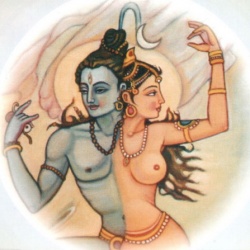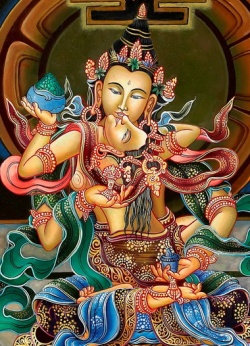Suspension of opposites
But let us first return to the apparently healthy continent of tantric eroticism. “It is through Love and in view of Love that the World unfolds, through Love it rediscovers its original unity and its eternal non-separation”, a tantric text teaches us (Faure, 1994, p. 56). Here too, the union of the male and female principles is a Constant topic. Our phenomenal World is considered to be the field of action of these two basic forces. They are manifest as polarities in nature just as in the spheres of the spirit. Each alone appears as just one half of the Truth. Only in their fusion can they perform the transformation of all contradictions into Harmony. When a human couple remember their metaphysical unity they can become one spirit and one flesh. Only through an act of Love can man and woman return to their divine origin in the continuity of all being. The tantric refers to this mystic event as yuganaddha, which literally means ‘united as a couple’.
Both the bodies of the lovers and the opposing metaphysical principles are united. Thus, in Tantrism there is no contradiction between erotic and religious Love, or sexuality and mysticism. Because it repeats the Love-play between a masculine and a feminine pole, the whole Universe dances. Yin and yang, or yab and yum in Tibetan, stand at the beginning of an endless chain of polarities, which proves to be just as colorful and complex as Life itself.
The “sexual” is thus in no way limited to the sexual act, but rather embraces all forms of Love up to and including agape. In Tantrism there is a polar eroticism of the Body, a polar eroticism of the Heart, and sometimes — although not always — a polar eroticism of the spirit. Such an omnipresence of the sexes is something very specific, since in other cultures “spiritual Love” (agape), for example, is described as an occurrence beyond the realm of yin and yang. But in contrast Vajrayana shows us how heterosexual erotic Love can refine itself to lie within the most sublime spheres of mysticism without having to surrender the principle of polarity. That it is nonetheless renounced in the end is another matter entirely.
The “holy marriage” suspends the duality of the World and transforms it into a “work of Art” of the creative polarity. The resources of our discursive Language are insufficient to let us express in words the Mystical fusion of the two sexes. Thus the “nameless” rapture can only be described in words which say what it is not: in the yuganaddha, “there is neither affirmation nor denial, neither existence nor non-existence, neither non-remembering nor remembering, neither affection nor non-affection, neither the cause nor the effect, neither the production nor the produced, neither purity nor impurity, neither anything with Form, nor anything without Form; it is but the synthesis of all dualities” (Dasgupta, 1974, p. 114).
Once the dualism has been overcome, the distinction between self and other becomes irrelevant. Thus, when man and woman encounter one another as primal forces, “egoness [is] lost, and the two polar opposites fuse into a state of intimate and blissful oneness” (Walker, 1982, p. 67). The tantric Adyayavajra described this process of the overcoming of the self as the “highest spontaneous common feature” (Gäng, 1988, p. 85).
The co-operation of the poles now takes the place of the battle of opposites (or sexes). Body and spirit, erotic Love and transcendence, emotion and intellect, being (Samsara) and not-being (Nirvana) become married. All wars and disputes between good and Evil, Heaven and Hell, day and night, dream and reality, Joy and Suffering, praise and contempt are pacified and suspended in the yuganaddha. Miranda Shaw, a religious scholar of the younger generation, describes “a Buddha couple, or male and female Buddha in union ... [as] an image of unity and blissful concord between the sexes, a state of equilibrium and interdependence. This Symbol powerfully evokes a state of primordial wholeness an completeness of being.” (Shaw, 1994, p. 200)
But is this state identical to the Unconscious ecstasy we know from orgasm? Does the suspension of opposites occur with both partners in a trance? No — in Tantrism God and goddess definitely do not dissolve themselves in an ocean of unconsciousness. In contrast, they gain access to the non-dual Knowledge and thus discern the eternal Truth behind the veil of illusions. Their deep awareness of the polarity of all being gives them the strength to leave the “sea of birth and Death” behind them.
Divine erotic Love thus leads to Enlightenment and salvation. But it is not just the two partners who experience redemption, rather, as the Tantras tell us, all of humanity is liberated through Mystical sexual Love. In the Hevajra-Tantra, when the goddess Nairatmya, deeply moved by the misery of all living creatures, asks her heavenly spouse to reveal the secret of how human Suffering can be put to an end, the latter is very touched by her request. He kisses her, caresses her, and, whilst in union with her, he instructs her about the sexual magic yoga practices through which all Suffering creatures can be liberated (Dasgupta, 1974, p. 118). This “redemption via erotic Love” is a distinctive characteristic of Tantrism and only very seldom to be found in other religions.

